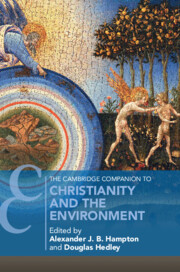Book contents
- The Cambridge Companion to Christianity and the Environment
- Cambridge Companions to Religion
- The Cambridge Companion to Christianity and the Environment
- Copyright page
- Contents
- Figures
- Contributors
- Preface
- 1 Introduction
- Part I Concepts
- Part II Histories
- Part III Engagements
- 14 The Sublime and Wonder
- 15 Religious Traditions and Ecological Knowledge
- 16 Venerating Earth
- 17 Nature and Aesthetics
- 18 Sophia and the World Soul
- 19 Creation and Gender
- Index
- Cambridge Companions to Religion
- References
14 - The Sublime and Wonder
from Part III - Engagements
Published online by Cambridge University Press: 21 July 2022
- The Cambridge Companion to Christianity and the Environment
- Cambridge Companions to Religion
- The Cambridge Companion to Christianity and the Environment
- Copyright page
- Contents
- Figures
- Contributors
- Preface
- 1 Introduction
- Part I Concepts
- Part II Histories
- Part III Engagements
- 14 The Sublime and Wonder
- 15 Religious Traditions and Ecological Knowledge
- 16 Venerating Earth
- 17 Nature and Aesthetics
- 18 Sophia and the World Soul
- 19 Creation and Gender
- Index
- Cambridge Companions to Religion
- References
Summary
The concepts of the sublime and wonder have a long and significant history in philosophy, literature and the arts, religion, and the history of science. These concepts identify kinds of human attitudes and responses to the natural world and to cultural practices and artifacts. This chapter will focus on the contemporary relevance of the sublime and wonder to questions and issues within the context of nature, environment, aesthetics, and religion. I begin with a brief, recent history of sublimity before examining the contemporary sublime in relation to environmental thought and “other-regarding attitudes” toward nature. I then consider recent cross-disciplinary discussions of the varieties of wonder and show how this attitude invites receptivity in relation to the more-than-human world. In the concluding section, I offer a comparison of the sublime and wonder to show, further, the different ways in which they may support sympathetic, ethical attitudes toward nature.
- Type
- Chapter
- Information
- The Cambridge Companion to Christianity and the Environment , pp. 217 - 230Publisher: Cambridge University PressPrint publication year: 2022



